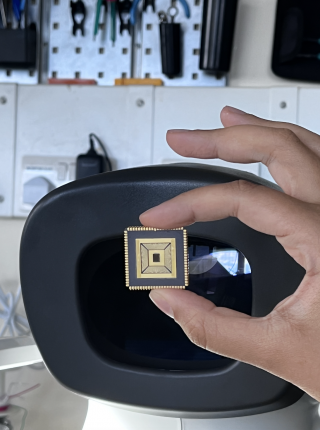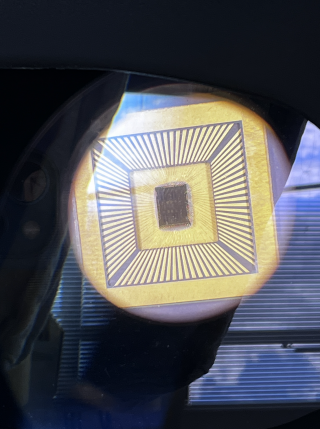Noora and designing a battery less power management circuit for medical devices
11 July 2022

Noora is a PhD student at the Electronic and Engineering Department. She’s working on designing a battery less power management circuit for medical devices. We asked Noora to speak to us about this ground-breaking work, what it means to start a PhD and be UCL’s Research Officer, supporting other Research students.
Tell us a bit more about the battery-less implantable devices? Why is this so significant for a medical implant?
You might not have heard of the term ‘implantable medical devices’ but you have heard of pacemakers, defibrillators, and deep brain stimulators. Implantable medical devices can monitor, communicate, diagnose, and treat various medical conditions but they’re powered by batteries which has a finite capacity and their bulky volume hinders long term use and comfortable deployment.
The size of these batteries can also no longer keep up with the miniaturisation trends in integrated electronics, therefore, battery-less implants that are powered through external or internal sources are steps toward the future of personalized medicine.

What clinical areas could it be applied to?
One way to think of our bodies is like a big circuit with the nerves being wires to different organs in the body and the brain being the microprocessor. When the signals are transmitted properly to the organs, the body is healthy. When there is an interruption or changes in the signals this can cause further health issues and so monitoring the body is important. Battery-less implants can be used for all clinical areas including cardiovascular, neurology, gastrointestinal, and much more. They also allow further testing of different rehabilitation approaches and help decrease invasiveness of devices.
What potential impact will this have on patients?
A possible application of this can be seen in Motor Neurone Disease.
Motor neurone disease (MND) destroys the motor neurons that can control the skeletal muscle activities leading to shortening of life expectancy. There is currently no cure for motor neurone disease and so stem cell derived motor neurons are put close to the targeted muscles to ensure muscle reinnervation before paralysis becomes irreversible. Recent studies have shown paralyzed muscles were innervated with stem cell motor neurons genetically modified with light sensitive ion channels can be optically stimulated to regain movement. Therefore, the combination of integrated electronics, optogenetics and stem cell technologies can help in treating motor neurone disease. The electronics are in an Application Specific Integrated Circuit (ASIC) consisting of both a power management unit and optical and electrical stimulation, and monitoring sensors.
The system that our group is working on is miniaturized for in vivo animal studies to ensure successful clinical translation of the therapeutically strategy of using light to reverse paralysis. My focus is designing battery less power management circuit to allow miniaturization to make the device less invasive and have a longer life time.

What's the next step in terms of your research and the device?
Our group is working on various implants and wearable medical devices and power management is a crucial block in every system to increase life time. In fact, power management is important in all electronic devices to control the amount of electricity extracted, used, and provide different levels of power as needed. Through my PhD, I got the chance to work with various researchers in the field on collaborative work and exciting projects. I also got to present my research at the Global Scientist Youth Summit by the National Research Foundation Singapore.
You're also the Research Students Officer - how is to juggle both a PhD and part-time student officer role?
I believe that there is always time to do more if you organize your time and spend it on things that you enjoy. Through this role I learned extensive policy writing and also leadership skills that are beneficial for widening my career options. In my role, I also proposed different policies and programmes including a multi-layer induction and the PhD Penpal programme.
I will also be taking part of the League of European Research Universities (LERU) programme in the Netherlands in the first week of July. The LERU is a society of prominent European research universities that want to influence the European policy agenda in the field of research, education and innovation. The Research Students’ Officer position helped me integrate my knowledge and experience into policy-making and giving back to UCL.
Any advice for people about to start a PhD?
Everyone starts from a different point. There are various ups and downs through the PhD journey but if you have the motivation, persistence, and determination then anything is possible. My biggest tip is making a to do list! Writing down what you need to do and breaking tasks into smaller tasks can help you achieve your goals much quicker.
 Close
Close

